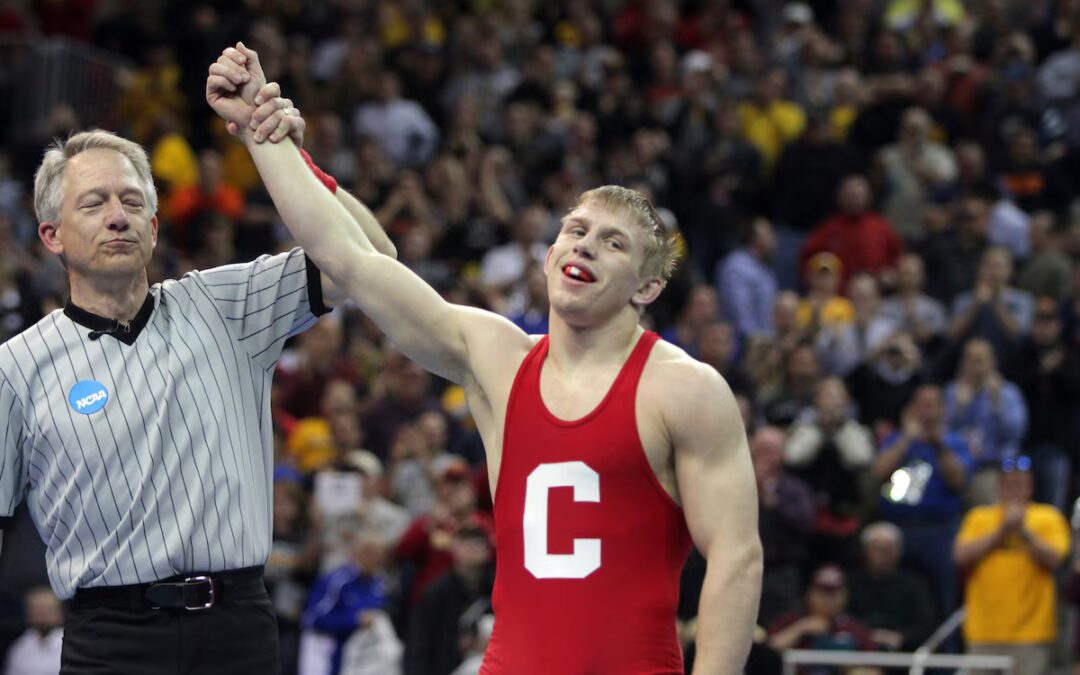Great wrestlers don’t just train, they learn from the best. High-level matches reveal lessons you can’t get from drilling alone: how to keep your composure when the stakes are highest, make tactical adjustments mid-match, and capitalize on every mistake your opponent makes.
The NCAA finals are the ultimate pressure cooker. Every second matters, and the smallest detail can decide a championship. These 10 bouts showcase different styles, strategies, and mindsets, all worth studying if you want to sharpen your own wrestling IQ.
HOW TO STUDY WRESTLING FILM EFFECTIVELY
Watching great matches isn’t just about entertainment, it’s about extracting details you can use. Here’s a simple approach:
First Watch – Big Picture:
Watch the match without pausing. Focus on pace, momentum shifts, and overall strategies.
Second Watch – Key Sequences:
Rewatch and pause after each score. Ask:
- What set up the move?
-
What mistake allowed it?
-
How did positioning or hand fighting create the opportunity
Third Watch – Focus on One Skill:
Pick one element (e.g., set-ups, mat returns, defense) and track only that throughout the match.
Take Notes & Apply:
Write down 2–3 actionable things you can try in practice that week.
Watch from Both Perspectives:
Study the winner and the opponent, you’ll learn as much from defending as attacking.
Kyle Dake vs. David Taylor – 2013 NCAA Final (165 lbs)
Backstory: Dake was going for his fourth NCAA title in four weight classes, a feat never achieved before. Taylor was the defending champion at 165 lbs and the 2012 Hodge Trophy winner, famous for his relentless scoring pace.
What Made It Great: Taylor scored first with an ankle pick, but Dake adjusted, shut down Taylor’s offense, and controlled the ties to win 5–4. It was a masterclass in pace control against one of the most dangerous scorers ever.
Key Takeaways:
-
Don’t panic after giving up early points.
-
Controlling ties can neutralize even elite offense.
-
Match tempo is a weapon.
Cael Sanderson vs. Daniel Cormier – 2001 NCAA Final (184 lbs)
Backstory: Sanderson was in the middle of his legendary 159–0 career. Cormier, a future UFC champion, was one of the most physical wrestlers in the country.
What Made It Great: Sanderson’s clean finishes and mat awareness prevented Cormier from dictating the match physically. His ability to score consistently without overextending was textbook.
Key Takeaways:
-
Chain wrestling wins against tough defense.
-
Position beats power when executed with precision.
-
Patience creates openings.
Jordan Burroughs vs. Tyler Caldwell – 2011 NCAA Final (165 lbs)
Backstory: Burroughs was returning from a redshirt year and aiming for his second NCAA title. Caldwell was known for slowing down explosive scorers.
What Made It Great: Burroughs broke through Caldwell’s defense with perfectly disguised level changes and crisp double legs, proving that one signature attack can dominate if set up correctly.
Key Takeaways:
-
Perfect your best attack.
-
Fakes and movement make defenses crumble.
-
Attack with confidence and commitment.
Backstory: Stieber, a freshman phenom, was chasing his second title. Oliver, a former NCAA champion, brought speed and technical precision.
What Made It Great: A tactical, high-paced battle decided by positioning and key finishes in scrambles. Stieber’s ability to stay composed under Oliver’s pressure sealed a 4–3 win.
Key Takeaways:
-
Tight finishes win close matches.
-
Stick to your plan under pressure.
-
Every point matters in low-scoring bouts.
Zain Retherford vs. Lavion Mayes – 2017 NCAA Final (149 lbs)
Backstory: Retherford, already a champion, faced Mayes — a dangerous scorer with explosive offense.
What Made It Great: Retherford delivered a rare finals tech fall, chaining takedowns into turns with relentless pace and pressure.
Key Takeaways:
-
Chain attacks build momentum.
-
Bonus points are possible at any level.
-
Conditioning can break opponents.
Spencer Lee vs. Nick Suriano – 2018 NCAA Final (125 lbs)
Backstory: Lee, a freshman, faced Suriano, an undefeated sophomore known for defensive discipline.
What Made It Great: Lee took control immediately, hitting a takedown and tilt combination to rack up early points and never look back.
Key Takeaways:
-
Strike first to control momentum.
-
Score turns before your opponent settles.
-
Fast starts can break a match open.
Gable Steveson vs. Wyatt Hendrickson – 2025 NCAA Final (285 lbs)
Backstory: Steveson, an Olympic gold medalist, and NCAA legend, returned seeking another title. Hendrickson, the underdog, came in with nothing to lose.
What Made It Great: In one of the biggest upsets in NCAA history, Hendrickson scored late to shock the wrestling world.
Key Takeaways:
-
Every match is winnable – never stop wrestling.
-
Late-match scoring opportunities can swing history.
-
Belief and preparation make upsets possible.
Anthony Robles vs. Matt McDonough – 2011 NCAA Final (125 lbs)
Backstory: Robles, wrestling with one leg, was already an All-American and fan favorite. This match was his chance to cap off his career with a title.
What Made It Great: Robles used a devastating tilt series to dominate McDonough, proving technique and leverage can trump physical disadvantages.
Key Takeaways:
-
Build a game no one else can replicate.
-
Top control can win championships.
-
Adapt your style to your strengths.
Kyle Snyder vs. Nick Gwiazdowski – 2016 NCAA Final (285 lbs)
Backstory: Snyder, an Olympic hopeful, faced Gwiazdowski, the two-time defending champion.
What Made It Great: A strategic heavyweight battle decided by a late Snyder takedown, showing patience and timing can win even at the highest level.
Key Takeaways:
-
Stay in position until the opportunity comes.
-
Late scoring wins tight matches.
-
Trust your conditioning in big moments.
Bo Nickal vs. Myles Martin – 2018 NCAA Final (184 lbs)
Backstory: Martin had shocked Nickal in the 2016 finals. In 2018, Nickal came in ready for redemption.
What Made It Great: Nickal scored the match-winner late, showing fearlessness in unconventional positions. His willingness to attack in scrambles turned the tide.
Key Takeaways:
-
Train to score from every position.
-
Composure in chaos is a skill.
-
Confidence changes outcomes.
Final Thoughts
Studying these matches is like adding years of experience to your wrestling journey. Each bout shows a different way to win, from shutting down a high-powered offense to staying calm and striking in the final seconds. The more you watch with a critical eye, the more patterns you’ll recognize and the faster you’ll adapt on the mat. Learn from the greats, apply their lessons in your training, and you’ll be ready when your championship moment comes.

